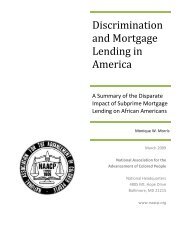TOOLKIT
TOOLKIT
TOOLKIT
You also want an ePaper? Increase the reach of your titles
YUMPU automatically turns print PDFs into web optimized ePapers that Google loves.
Project: EPA OnCampus ecoAmbassadors<br />
OnCampus ecoAmbassadors choose to implement one<br />
environmental activity from a menu of options, such as increasing<br />
energy efficiency on campus, reducing water use, and<br />
implementing a composting program. Students are encouraged to<br />
recruit help from friends and organizations on campus. There’s no<br />
limit to the number of projects students can complete!<br />
EcoAmbassadors are equipped with EPA materials and a<br />
Facebook community to engage members of their campus and<br />
students across the country. Upon completion of each activity and<br />
sponsor endorsement, each student will receive a certificate of<br />
completion from the EPA and the school will receive sustainability<br />
leaves to track progress. Schools that complete activities of higher<br />
difficulty will be awarded more leaves. Students from schools that<br />
complete multiple activities within a school year will have the<br />
opportunity to visit the EPA at both the regional and national level.<br />
During these spring semester visits, students will meet with<br />
program staff and leadership.<br />
Walk:<br />
The EPA EcoAmbassador program is an extensive program as<br />
seen above. For each youth council/college member who becomes<br />
an ambassador, the group will receive 50 steps.<br />
Run:<br />
Complete a Pick 5 event from one of the EPA areas of interest:<br />
Air/Water, Energy, Health/Advocacy, Land or Waste and lead a<br />
campus/community teach-in about the subject.<br />
Sprint:<br />
Participate in the Green Power Partnership Project that encourages<br />
organizations to reduce greenhouse gas emissions by purchasing<br />
electricity produced from renewable resources such as solar, wind,<br />
geothermal, biomass, and low-impact hydroelectric.<br />
www.epa.gov/ecoambassadors/oncampus/pdf/gpp_year2.pdf<br />
MILE MARKER 9:<br />
PROTECTING THE GREAT<br />
OUTDOORS<br />
Resources<br />
ecoAmbassadors:<br />
www.epa.gov/ecoambassadors/oncamp<br />
us/index.html<br />
Student Environmental Action Coalition<br />
(SEAC): www.seac.org/<br />
Youth Environmental Justice Network:<br />
http://youthunited.net/yucadwpgs/YEJ%2<br />
0only/yucayejnetwork.htm<br />
Energy Action Coalition:<br />
www.energyactioncoalition.org/about<br />
Reporting<br />
Remember that different forms of<br />
movement are worth specific steps.<br />
Walk = 50 steps<br />
Run = 100 steps<br />
Sprint = 150 steps<br />
Hydration Stations = 25 steps<br />
In order to receive credit for the 10,000<br />
steps all activities must be documented.<br />
To report projects, click on this<br />
link<br />
Fill out the form titled<br />
REPORTING.<br />
Please make sure all the text<br />
boxes are filled out completely.<br />
It is also recommended that activities are<br />
uploaded to the official NAACP pages<br />
listed below with a brief commentary<br />
which includes:<br />
Name of Youth Council/College<br />
Chapter<br />
<br />
<br />
Location<br />
2-4 sentences describing the<br />
activity.<br />
When using social media, use the<br />
hashtags: #10KSteps, #NAACPECJP or<br />
tag NAACP, NAACPConnect,<br />
NAACPECJP.<br />
51 | P a g e








